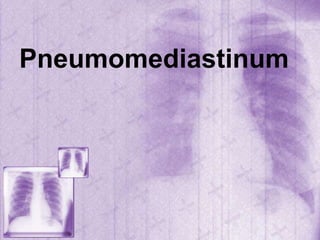
Pneumomediastinum
- 2. * More Common Among Children and Neonates • First Described By Laennec 1819 as a consequence of Traumatic Injury • Then Spontaneous Pneumomediastinum was described by Hamman in 1939 * Rare Condition
- 3. It is defined as free air or gas contained within the mediastinum, which almost invariably originates from the alveolar space or the conducting airways.
- 5. Spontaneous • Rupture of Marginally Situated Alveoli (high intraalveolar pressure) • Erosion of a Tracheal Or Esophageal Tumor •Pneumoperitoneum, Pneumoretroperitoneum
- 6. Traumatic • pulmonary interstitial emphysema (positive pressure ventilation) • ruptured bronchus (commonly associated with pneumothorax) • ruptured esophagus (diabetic acidosis, alcoholic, Boerhaave)
- 7. Pathophysiology The Macklin Effect 1944 o alveolar rupture o air dissection along the bronchovascular sheath o free air reaching the mediastinum
- 8. Complications Rarely leads to significant complications by it self Significant Illness Comorbid Disease Trauma
- 9. Tension Pneumomediastinum • Rare • Elevated Mediastinal pressure leads to diminished cardiac output, either by: • When extensive subcutaneous and mediastinal gas is present, airway compression may also occur. direct cardiac compression reduced venous return
- 10. Statistics • SPM from 1 per 800 to 1 per 42,000 pediatric patients presenting to ER. from 1 per 12,000 to 1 per 30,000 admission to the hospital. 0.3% incidence of PM in association with asthma over a 10-year period. • TPM 10% of blunt chest injury patients will develop PM.
- 11. Mortality & Morbidity SPM is a self limited condition are generally attributable to underlying disease states. as high as 50-70% as seen in Boerhaave syndrome is not associated with an increased mortality rate in patients with sepsis-induced ARDS
- 12. Gender 29 cases of SPM over a 10-year period, 69% were males Is a body habitus favoring a tall thin build is an additional risk factor for the development of SPM? TPM is more common in males, reflecting the male predominance among those who experience trauma and accidents.
- 13. Age The peak prevalence of SPM is seen in the second to fourth decades of life. reflects involvement in activities that increase the risk of developing SPM the force of an individual's cough, vomit, and Valsalva maneuvers (all of which may lead to PM) attenuates with age The age distribution for PM occurring in conjunction with specific disease processes reflects the age profile of the particular disease.
- 14. Clinically • Chest pain • Dyspnea • Fever • Dysphonia • Throat pain • Jaw pain • Miscellaneous : Dysphagia, neck swelling, and torticollis
- 15. Chest pain IN SPM said to be a feature in 50-90% of cases • retrosternal in location • worsened by inspiratory maneuvers • may radiate to the shoulders or back thus suggesting MI or pericarditis in 27% of persons with asthma with PM
- 16. Dyspnea may reflect associated illnesses such as asthma, a coexistent pneumothorax, or a tension PM.
- 17. Fever Low-grade fever may be present following cytokine release that is associated with air leak. mediastinitis or infectious/inflammatory disorders should be included in the differential diagnosis Dysphonia
- 18. Signs • Subcutaneous air •The Hamman sign •Associated pneumothorax •Other diseases •Oxygen saturation
- 19. • not pathognomic of PM •subcutaneous emphysema in 73% of patients presenting with asthma subsequently found to have PM. •The positive predictive value of this sign for PM in the previous series was 100%. Subcutaneous air
- 22. The Hamman sign • pathognomic of PM • precordial systolic crepitations and diminution of heart sounds • prevalence of 10% to 50% PM patients
- 23. Oxygen saturation • Pulse oximetry is mandatory in all patients with suspected PM •In a series of children with asthma presenting to an emergency department, those with PM had a significant difference in oxyhemoglobin saturation (90% vs 94% of those without PM, p = 0.03).
- 24. Work Up Chest X-Ray usually reveals a pneumomediastinum. • thymic sail sign •"ring around the artery" sign •double bronchial wall sign •continuous diaphragm sign •the extrapleural sign
- 28. Subcutaneous air
- 30. CT-Scan • provide additional diagnostic information regarding the presence of coexisting illness •in diagnosing small pneumomediastinum not visible on chest radiography. chest radiography alone may result in a missed diagnosis in 10% of patients presenting with pneumomediastinum.
- 31. Contrast radiography suspected esophageal perforation ABG ECG
- 32. Spirometry ? should not be undertaken in patients with pneumomediastinum because the increased alveolar pressures may further exacerbate the air leak.
- 33. Treatment Medical Care • Most are Asymptomatic Spontaneously resolve • Adequate analgesia • Some Points mechanical ventilation & PM? high-frequency oscillatory ventilation Children with ARDS and PM? Nitrogen washout with inhalation of 100% oxygen
- 34. • The use of the lowest pressures or tidal volumes necessary to achieve satisfactory carbon dioxide removal and oxygenation. Mechanical Ventilation & PM? • Permissive hypercapnia, a ventilatory strategy that is based on maintaining adequate oxygenation and blood pH while allowing high partial pressure of carbon dioxide, allows for ventilatory support while minimizing barotrauma.